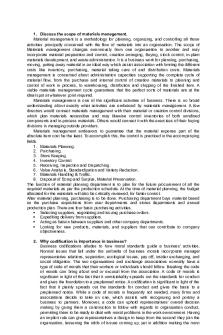The Scope Of Environmental Economics PDF

| Title | The Scope Of Environmental Economics |
|---|---|
| Course | Business Environment |
| Institution | Christ (Deemed To Be University) |
| Pages | 2 |
| File Size | 77 KB |
| File Type | |
| Total Downloads | 97 |
| Total Views | 172 |
Summary
The Scope Of Environmental Economics...
Description
Asynchronous Activity 1: Environmental Law The environment is under constant threat due to energy-intensive technologies, agricultural and industrial technologies based on synthetic organic chemicals, unprecedented levels of urbanization etc. According to Robert F. Rooney, these are externalities and their effect on the environment interests economists. The Author in the first section of the article talks about various concerns that characterize the scope of environmental economics. The Scope Of Environmental Economics 1. The concept of environmental economics as mentioned in the article primarily focuses on externalities that impact the economic activity on the natural environment. The author draws a comparison between environmental economics and the law of torts. Even though much of the law of torts is devoted to deciding how to compensate damaged persons for a loss in well being inflicted by the actions of others. However, most of the important externalities cannot be handled under the law of torts hence it became the primary focus for environmental economists. 2. The next concern that environmental economics deals with is the impact of human activity on the natural ecosystem’s extent, quality, and stability. The field of environmental economics is concerned with these issues as they are usually the outcome of people's actions to grow their wealth, or government initiatives to create a better quality of life etc. 3. The Final concern that the author mentioned in this article was the evolution of the various economic, political and social goals, which control individual and collective use of the natural environment. Towards the end of the first part, the author also explains how the rise in technologies in the past 50 years has demanded a legal framework to reflect the realities of air, water, noise pollution, natural resource depletion, etc. These developments gave rise to the integration of law and economics Economic Efficiency And The Maximize Wealth Goal In the next part of the article, the author focused on the concepts of economic efficiency and maximising wealth goals. According to the author, the social goal implied by contemporary concepts of economic efficiency is that of maximizing the market value of the nation's capital, labour and natural resources. The maximize wealth goal means that it is efficient to adopt policies and regulations and to make court decisions that increase the value of the goods and services produced and consumed by society.
Under the discussion of wealth maximisation, the author introduces the concept of Pareto optimality. Pareto optimality exists whenever any change in the allocation of resources will result in at least one person being made worse off He further discusses how the law of diminishing returns, the law of rising marginal cost, the law of substitution, and the law of diminishing value are some of the most important ideas used to predict the behaviour of company executives, customers, and government officials. He goes on to say that if the value of the last MU>MC, it is regarded economically efficient to do one more unit of activity while reducing the value of another activity. In any scenario, from the standpoint of the decision-maker, growing one specific activity will indefinitely raise the MC while decreasing its value, eventually reaching a point where MC=MV. When the items in question are private assets with uncontested property rights, the decision-maker can afford to make an unambiguous choice between two or more uses of their resources. He backs this up with a quote from Coase on externalities: ‘to prevent person A from doing an action that would affect person B would have the effect of allowing person B to injure A.' This obstructs us from reaching a Pareto efficient outcome. Wherever externalities are concerned, the aim immediately shifts to law and policymaking and where the decision involves the creation of benefits that the decision-maker can’t procure through a market transaction, the objective here changes to one of the developing institutions that incentivise the decision-maker to take into consideration, all the benefits to other people as a consequence of his decisions....
Similar Free PDFs

Environmental Economics
- 493 Pages

The Scope of Judicial Review
- 6 Pages

Scope of Rural Sociology
- 9 Pages
Popular Institutions
- Tinajero National High School - Annex
- Politeknik Caltex Riau
- Yokohama City University
- SGT University
- University of Al-Qadisiyah
- Divine Word College of Vigan
- Techniek College Rotterdam
- Universidade de Santiago
- Universiti Teknologi MARA Cawangan Johor Kampus Pasir Gudang
- Poltekkes Kemenkes Yogyakarta
- Baguio City National High School
- Colegio san marcos
- preparatoria uno
- Centro de Bachillerato Tecnológico Industrial y de Servicios No. 107
- Dalian Maritime University
- Quang Trung Secondary School
- Colegio Tecnológico en Informática
- Corporación Regional de Educación Superior
- Grupo CEDVA
- Dar Al Uloom University
- Centro de Estudios Preuniversitarios de la Universidad Nacional de Ingeniería
- 上智大学
- Aakash International School, Nuna Majara
- San Felipe Neri Catholic School
- Kang Chiao International School - New Taipei City
- Misamis Occidental National High School
- Institución Educativa Escuela Normal Juan Ladrilleros
- Kolehiyo ng Pantukan
- Batanes State College
- Instituto Continental
- Sekolah Menengah Kejuruan Kesehatan Kaltara (Tarakan)
- Colegio de La Inmaculada Concepcion - Cebu












